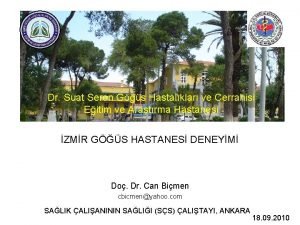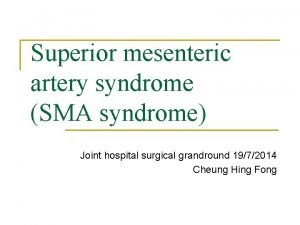Isolated Superior Mesenteric Artery Dissection Authors Dr Seren



- Slides: 3

Isolated Superior Mesenteric Artery Dissection Authors: Dr Seren Peters, ST 2 Radiology, Dr Bruce Fox, Consultant Radiologist Affiliations: Dr Richard Riordan, Consultant Radiologist

Case synopsis • 61 year old male with a background of previous anterior resection in 2017 for sigmoid adenocarcinoma, and previous Aortic type A dissection repair in 2016. • The patient presented to the hospital having not opened their bowels or passed flatus for two days, with a tender and distended abdomen. The clinical team requested a CT abdomen and pelvis to rule out obstruction. • The portal venous phase CT abdomen showed no evidence of obstruction, and no other abnormality of the bowel found including at the site of anastomosis. The only abnormality identified in the abdomen was some minor fat stranding around the SMA. There was the suggestion of subtle intravascular low attenuation and it was postulated that it may represent thrombus, with the caveat this was not a dedicated angiographic study and the appearances may be secondary to the portal venous phase of the study. • A CT angiogram was recommended to clarify appearances. Whilst the patient’s pain had since settled, CT angiogram was performed later the same day. The angiogram demonstrated an isolated superior mesenteric artery dissection, with an intimal flap arising from the proximal vessel approximately 2 cm from origin and extending approximately 8 cm along the length of the vessel. At least one major branch (thought to be one of the pancreatico-duodenal arteries) was seen to arise from the false lumen. There was no associated aortic dissection, and no further abnormality was identified.

Fig. 1 Axial section portalvenous phase abdomen. Hypodensity and fat stranding around the mid-SMA. Fig. 3 Sagittal section portalvenous phase abdomen. Hypodensity within the SMA lumen and associated fat stranding. Fig. 2 Axial arterial phase abdomen. Dissection flap seen in the lumen of the SMA with associated fat stranding. Fig. 4 Sagittal section arterial phase abdomen. Dissection flapand intramural haematoma seen in the lumen of the SMA with associated fat stranding.




